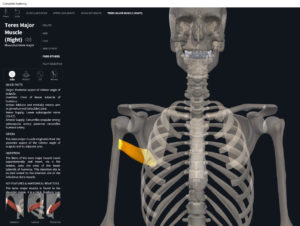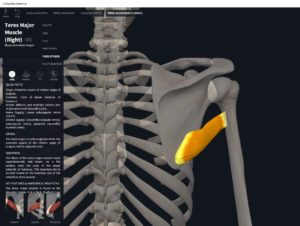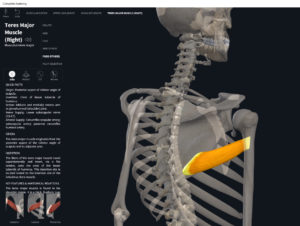Anatomy & Physiology: Muscles—Teres Major.
Structure.
- Origin: inferior angle of scapula.
- Insertion: medial lip of intertubercular sulcus of humerus.
Function.
- Concentric action: shoulder internal/medial rotation, adduction, and extension.
- Reverse mover action: upward rotation of the scapula. Downward tilt of scapula.
- Eccentric action: shoulder external rotation, abduction, and flexion. Controls/restrains/slows downward rotation and upward tilt of scapula.
- Isometric action: stabilization of the shoulder girdle and scapula.
- Innervation: lower subscapular nerve.
- Arterial supply: circumflex scapular artery (branch of subscapular artery); thoracodorsal artery (continuation of subscapular artery).
Clinical Significance.
More.
- https://www.anatomynext.com/teres-major/
- https://www.physio-pedia.com/Teres_Major
- https://www.youtube.com/watch?v=SADy_lEFCdg
- https://www.youtube.com/watch?v=DSaVkfIcwhU
References
Biel, A. (2015). Trail guide to the body: A hands-on guide to locating muscles, bones and more.
Cedars-Sinai. (2018). Vertebrae of the spine. Retrieved from https://www.cedars-sinai.org/health-library/diseases-and-conditions/v/vertebrae-of-the-spine.html
Clark, M., Lucett, S., Sutton, B. G., & National Academy of Sports Medicine. (2014). NASM essentials of corrective exercise training. Burlington, MA: Jones & Bartlett Learning.
Jenkins, G., & Tortora, G. J. (2012). Anatomy and Physiology: From Science to Life, 3rd Edition International Stu. John Wiley & Sons.
Muscolino, J. E. (2017). The muscular system manual: The skeletal muscles of the human body.



